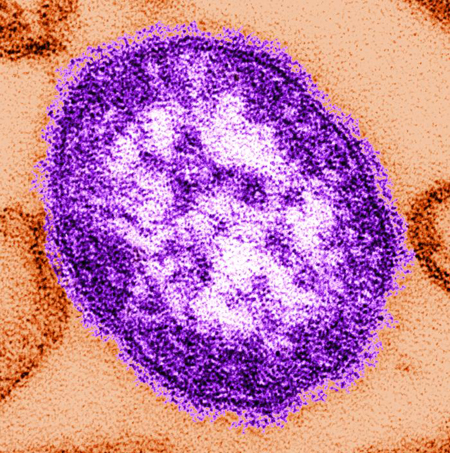შეჯამება
განსაზღვრება
ანამნეზი და გასინჯვა
ძირითადი დიაგნოსტიკური ფაქტორები
- potential exposure to measles
- unvaccinated/incompletely vaccinated individuals
- fever
- cough
- coryza
- conjunctivitis
- Koplik spots
- maculopapular rash
რისკფაქტორები
- exposure to measles virus
- no prior immunization against measles
- failure to respond to measles vaccine
დიაგნოსტიკური კვლევები
გასათვალისწინებელი კვლევები
- acute and convalescent sera for measles-specific IgG
- measles RNA detection by PCR
- antigen detection by fluorescent antibody or PCR techniques
- isolation of virus in tissue culture system
მკურნალობის ალგორითმი
კონტრიბუტორები
ავტორები
Elizabeth Barnett, MD
Professor of Pediatrics
Boston University School of Medicine
Boston Medical Center
Boston
MA
გაფრთხილება:
EB receives clinical trial funds from Pfizer (COVID, PCV20, and RSV vaccines) and GSK (MMRV vaccine). She receives royalties from Elsevier (Immigrant Medicine), AAP (Nelson's antimicrobial therapy), and honoraria from AAP (Red Book). She participated in an Advisory Board (Sobi, RSV).
რეცენზენტები
Sharon Nachman, MD
Professor of Pediatrics
Division Chief Pediatric Infectious Disease
State University of New York at Stony Brook
Stony Brook
NY
გაფრთხილება:
SN declares that she has no competing interests.
Linda Nield, MD, FAAP
Professor of Pediatrics
West Virginia University School of Medicine
Morgantown
WV
Disclosures
LN is an author of a reference cited in this topic.
Aisha Sethi, MD
Assistant Professor of Medicine
Associate Residency Program Director
University of Chicago
Chicago
IL
Disclosures
AS declares that she has no competing interests.
Peer reviewer acknowledgements
BMJ Best Practice topics are updated on a rolling basis in line with developments in evidence and guidance. The peer reviewers listed here have reviewed the content at least once during the history of the topic.
Disclosures
Peer reviewer affiliations and disclosures pertain to the time of the review.
References
Key articles
McLean HQ, Fiebelkorn AP, Temte JL, et al; Centers for Disease Control and Prevention. Prevention of measles, rubella, congenital rubella syndrome, and mumps, 2013: summary recommendations of the Advisory Committee on Immunization Practices (ACIP). MMWR Recomm Rep. 2013 Jun 14;62(RR-04):1-34.Full text Abstract
Centers for Disease Control and Prevention. Child and adolescent immunization schedule: recommendations for ages 18 years or younger, United States, 2025. Nov 2024 [internet publication].Full text
UK Health Security Agency. Measles: the green book, chapter 21. Dec 2019 [internet publication].Full text
Centers for Disease Control and Prevention. Adult immunization schedule: recommendations for ages 19 years or older, United States, 2025. Nov 2024 [internet publication].Full text
Committee on Infectious Diseases, American Academy of Pediatrics. Measles. In: Kimberlin DW, Banerjee R, Barnett ED, et al, eds. Red Book: 2024-2027 Report of the Committee on Infectious Diseases. 33rd ed. Itasca, IL: American Academy of Pediatrics; 2024.Full text
Reference articles
A full list of sources referenced in this topic is available here.
ამ მასალის გამოყენება ექვემდებარება ჩვენს განცხადებას

